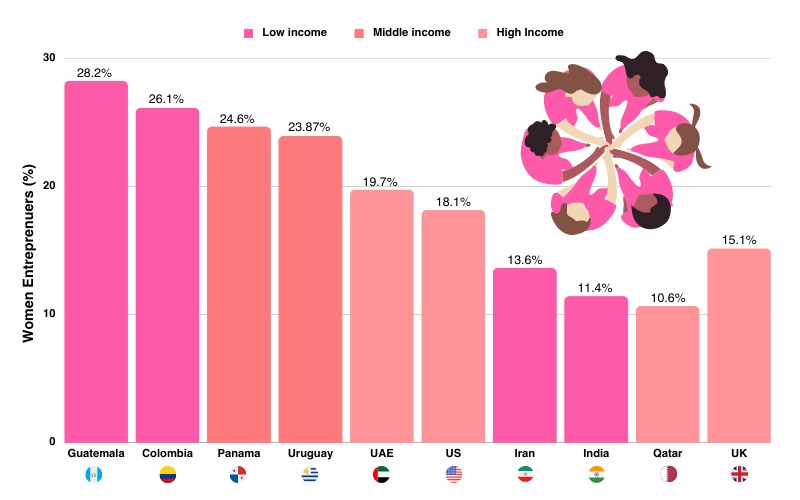Breaking Barriers: Empowering Women Entrepreneurs Worldwide

This blog post has been authored by Shubhangini Singh, Economics Researcher at Arthashastra Intelligence
“I think the biggest challenge that women entrepreneurs face is that there is still a very limited perception of what women can and cannot do. Breaking those perceptions, stereotypes, and biases is an ongoing battle. We have to constantly prove ourselves, not just as entrepreneurs, but as leaders who are capable of making a significant impact in any industry.” – Indra Nooyi
In the dynamic world of entrepreneurship, women are carving their paths and making remarkable strides. To shed light on this fascinating landscape, we embark on a data-driven journey to compare countries and identify the key factors that shape women’s entrepreneurship.
Through this data story, we explore the untold narratives of women entrepreneurs who have overcome challenges and shattered glass ceilings. We draw inspiration from visionaries like Sara Blakely, founder of Spanx, who expanded her brand globally and championed the cause of women’s empowerment through her foundation. Their stories remind us of the biases and barriers that women entrepreneurs face, from unequal funding access to limited networking opportunities.
What Data Suggests?
Data from a Pew Research Center survey reinforces the need for change. It highlights the stark reality that women often encounter gender discrimination in the workplace, with disparities in income, perception of competence, and access to senior leadership support. These statistics remind us of the importance of fostering an inclusive environment that values and supports women entrepreneurs.
Source: Global Entrepreneurship Monitor; Compilation and Visualization By Arthashastra Intelligence.
The Global Entrepreneurship Monitor 2022-2023 report adds depth to our analysis, revealing intriguing insights. While male Total Early-stage Entrepreneurial Activity (TEA) typically outnumbers that of women, countries like Togo, Indonesia, Poland, and Qatar boast higher rates of female TEA. We also uncover a gender gap in established business ownership, suggesting the ongoing need for progress in achieving gender equality in entrepreneurship.
Women entreprenuers and COVID-19
The pandemic’s impact on the gender gap in entrepreneurship cannot be overlooked. Initial speculations hinted at disproportionate setbacks for women entrepreneurs due to increased responsibilities at home and vulnerabilities in certain sectors. However, data from the GEM APS in 2022 compared to 2019 presents a more complex reality. While female-to-male entrepreneurship ratios decreased in some economies, others witnessed an increase, challenging the initial assumptions. India and Oman experienced significant growth, while Saudi Arabia and Greece faced declines.
Women in Startups
Digging deeper, we find that age plays a role in entrepreneurial engagement. Younger adults tend to be more involved in new business ventures, highlighting the potential for fostering business growth through higher education and supporting graduates in their entrepreneurial pursuits.
As we shift our focus to major economies, we uncover both progress and persistent challenges. In India, the GEM Women’s Report 2020/2021 showcases the need for addressing barriers such as limited financial access and cultural norms. China, while witnessing an increase in women’s entrepreneurship, grapples with ongoing gender discrimination. In the United States, women-owned businesses represent a significant portion, but funding access remains an obstacle. The United Kingdom and Germany also face gender disparities in entrepreneurship, emphasizing the importance of addressing issues such as limited networks, bias, and access to financing.
Notable multinational corporations such as Deloitte, PwC, EY, and KPMG are actively promoting gender equality in entrepreneurship. Through initiatives, programs, and reports on gender diversity, they are reshaping the entrepreneurial landscape and encouraging inclusivity.
Governments, too, play a pivotal role in fostering women’s economic empowerment. In India, schemes like Stand-Up India and the Women Entrepreneurship Platform provide financial assistance, networking opportunities, mentorship, and incubation support. These initiatives aim to create an enabling environment for women entrepreneurs, removing hurdles and nurturing their ventures.
In conclusion, this data story illuminates the multifaceted factors that influence women’s entrepreneurship across countries. As we unravel the intricate tapestry of cultural, social, and economic dynamics, we gain valuable insights into the challenges faced and the progress achieved. While significant strides have been made, there is still work to be done in creating an inclusive environment that empowers women entrepreneurs. Together, through collaborative efforts from corporations, governments, and society at large, we can pave the way for a future where women’s entrepreneurship knows no bounds.
References:
- Retrieved from Pew Research Center (Author: Kim Parker and Cary Funk) Gender discrimination comes in many forms for today’s working women
- Retrieved from Cubo (Author: Obbaatt Angadia) Spotlight on women entrepreneur: Sara Blakely
- Retrieved from Bene (Author: Bene Team) A Conversation on Gender Inequality with Arianna Huffington
- Retrieved from Inc. (Author: Lisa Abeyta) How Did Netflix’s ‘Girlboss’ Get It So Wrong About Women Entrepreneurs?
- Retrieved from GEM Consortium (Author: GEM Consortium) Global Entrepreneurship Monitor Report 2022-23
- Retrieved from Fundera (Author: Maddie Shepherd) Women-Owned Businesses: Statistics and Overview
- Retrieved from Forbes (Author: Shama Hyder) State Of Women And Entrepreneurship 2020: Here’s What You Need To Know
- Retrieved from Score (Author: Rieva Lesonsky) The State of Women Entrepreneurs
- Retrieved from Harvard Business Review (Author: Ashley Bittner and Brigette Lau) Women-Led Startups Received Just 2.3% of VC Funding in 2020
- Retrieved from Natwest Group (Author: Natwest Group) The Alison Rose Review of Female Entrepreneurship: The Story Continues
- Retrieved from KFW (Author: Christine Volk) KfW Research: Desire for self-employment at record low in Germany
- Retrieved from Forbes (Author: Christina Carosella) Why Gender Equality Matters In Business Success
- Retrieved from Deloitte (Author: Allson Roglsh, Neda Shemluck, Patty Danlelechi, Samla Hazurla) Advancing more women leaders in financial services: A global report
- Retrieved from PWC (Author: PWC) Empowering women in the workplace
- Retrieved from EY (Author: EY) Diversity, equity and inclusiveness
- Retrieved from KPMG (Author: KPMG) Perspectives on innovation and technology for gender equality
- Retrieved from Indifi (Author: Indifi) Best 9 Government Schemes For Women Entrepreneurs In India
- Retrieved from Startup India (Author: Startup India) Women Entrepreneurship in India
